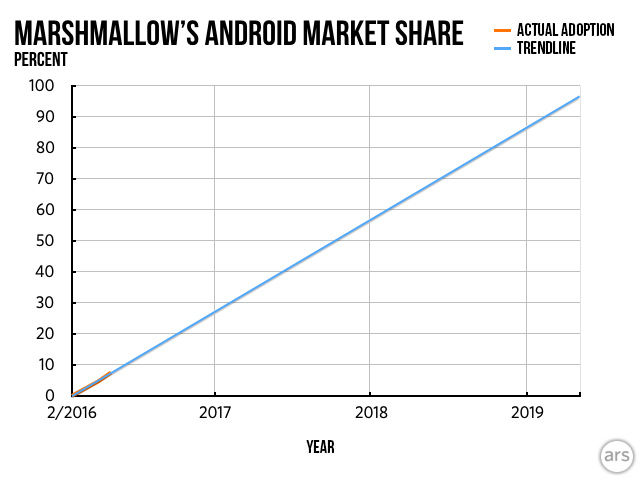
This just in: Android updates are still really slow. The latest numbers put the seven-month-old Android 6.0 Marshmallow at just 7.5 percent of devices. That's an average of just over one percent per month, so if this keeps up, by 2020 the majority of devices will be compatible with Marshmallow or higher. Great.
Google's latest attempt at fixing Android's update problem reportedly involves "a list." On this list, OEMs are ranked by how fast they deliver updates, which the report says is used to "highlight proactive manufacturers and shame tardy vendors." Google has even thought about making this list public.
Does anyone think this is going to work? Can "shame" really be the driving force behind getting companies to update? We'd imagine "making the list public" would mean posting it to a website—is that really going to compete with the millions of dollars these companies spend on advertising?
Enthusiasts and people who do research beforehand will already know that most OEMs and carriers have awful update reputations, so what market will this really be addressing? It's the mass market that really needs this information—the people that walk into a Verizon store to buy "the new Galaxy" that they saw on TV. These people won't see Google's "partner shaming" list. The list will have no power if no one pays attention to it, and short of a massive (and unlikely) marketing push by Google, no one will.

Google keeps missing the point when it comes to addressing Android's update situation. It keeps coming up with strategies to make updating "easier" for OEMs, but I don't think the problem is "ease of updating"—it's creating any incentive for OEMs to update at all. Google seems to think that its partners will update phones because it's The Right Thing To Do by their customers and that handing out gold stars will send them scrambling to produce updates for their devices. I don't think that's ever going to happen.
Google actually already tried the "shame" tactic and it didn't work. When Google owned Motorola, Moto's update speed went through the roof. Motorola was achieving near-Nexus-like update speeds on many of its phones and was definitely putting other manufacturers to shame. But the increased update competition never really spurred other OEMs to start competing on update speeds.Googlerola was also a sign that OEMs don't really care about "ease of updating" either. Part of the entire Motorola exercise was to show other OEMs how it's done and provide a blueprint on how to differentiate Android while not messing with the core OS so much that updating became difficult. By differentiating in apps, minimizing arbitrary changes to Android, and working with carriers, it managed to provide a nearly Nexus-like update speed. This has been copied by precisely zero OEMs. Deep changes to the OS are still made, pointless reskinning of every image resource still happens, and updates still take upwards of three months. Google gave a great lesson with Motorola but no one was listening.
Start speaking the OEMs' language (the language is money)
The bottom line is that Android partners only care about, well, the bottom line—money. These companies already have your money, so updating a device that's already been sold is a needless expense. There's also a good argument to be made that updating a device hurts future sales. If your phone isn't updated, it will start to feel old, so you're more likely to buy a new phone sooner.
If Google really wants to fix Android's update situation, it needs to start working with Android partners and make it actually worth their while to update. We've heard reports that Google shares ad revenue with its partners—if a customer buys a Verizon Samsung phone, performs a Google search, and clicks on an ad, Verizon and Samsung get a portion of that ad revenue. So, penalize partners by reducing or eliminating that revenue sharing if they don't push out updates. If an OEM exceeds the curve and stays up to date, increase the amount of revenue sharing. Threatening to shift the stock price of an OEM by affecting its bottom line is the nuclear option—and, folks, we're at the point where the nuclear option is all that's left.I don't think it's a crazy statement to say "companies primarily care about money," and we doubt there is any evidence out there that proves providing consistent updates for your customers improves the bottom line. Sure it will earn a company the respect of enthusiasts, but that market probably isn't big enough to move the needle much. We think directly paying partners via some kind of tiered system would be a good way to get their attention. Google would finally start speaking their language, the language of cold, hard cash.
Unlike Google's update rankings, a backroom deal also has the benefit of affecting every customer equally regardless of how much research they do before the purchase. Android partners would be incentivized to update quickly, since every day they don't update is another day of lost ad revenue. It would push them to update the most popular devices first, since those would have the highest share of ad clicks. We also can't imagine that it would cost Google a ton more money since, remember, it is already doing this. We're just suggesting it attach a tiered system to the ad share model.
As it stands today, OEMs don't have much reason to listen to Google when it comes to updates. There's just no incentive. Carriers get money from monthly bills, OEMs get money from the hardware sales, Google gets money from Play store sales and ad revenue. If Google really wants the Android update situation to get better, it should put its money where its mouth is.
Correction: The original trendline chart was just a straight average of the past few months of updates. Android's adoption rate always speeds up after a slow starting period, so we updated the chart to ignore the first few slow months of Marshmallow's launch.
reader comments
232